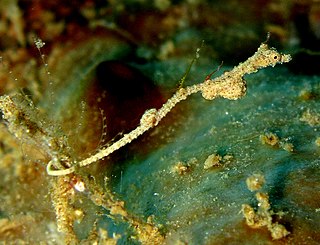
A seahorse is any of 46 species of small marine fish in the genus Hippocampus. "Hippocampus" comes from the Ancient Greek hippókampos (ἱππόκαμπος), itself from híppos (ἵππος) meaning "horse" and kámpos (κάμπος) meaning "sea monster" or "sea animal". Having a head and neck suggestive of a horse, seahorses also feature segmented bony armour, an upright posture and a curled prehensile tail. Along with the pipefishes and seadragons they form the family Syngnathidae.

The angelsharks are a group of sharks in the genus Squatina of the family Squatinidae. They commonly inhabit sandy seabeds close to 150 m (490 ft) in depth. Many species are now classified as critically endangered by the International Union for Conservation of Nature. Once common over large areas of the Northeast Atlantic from Norway, Sweden, Morocco and the Canary Islands, to the Mediterranean and Black Seas, fishing pressure has resulted in significant population decline.

The banded bullfrog is a species of frog in the narrow-mouthed frog family Microhylidae. Native to Southeast Asia, it is also known as the Asian painted frog, digging frog, Malaysian bullfrog, common Asian frog, and painted balloon frog. In the pet trade, it is sometimes called the chubby frog. Adults measure 5.4 to 7.5 cm and have a dark brown back with stripes that vary from copper-brown to salmon pink.

Tetrigidae is an ancient family in the order Orthoptera, which also includes similar families such as crickets, grasshoppers, and their allies. Species within the Tetrigidae are variously called groundhoppers, pygmy grasshoppers, pygmy devils or "grouse locusts".
Sam W. Heads is a British palaeontologist, a Fellow of the Linnean Society of London, a Fellow of the Royal Entomological Society, as well as a former Officer and Editor-in-Chief at the Orthopterists' Society.

Discotettix is a genus of pygmy grasshoppers found in Malesia, Brunei, Indonesia and the Philippines. They are commonly known as spiky pygmy devils. After revision of this genus, from being the type genus of the subfamily Discotettiginae, it is now placed in the tribe Scelimenini.

The thread pipefish, also known by its Japanese standard name Hari-youji, is a species of pipefish native to the Pacific Ocean around Indonesia, where it is found at depths from 15 to 20 m. This species grows to a length of 2.68 cm (1.06 in), and is the only known member of its genus.

Marleyimyia xylocopae is a species of bee fly from South Africa that has a similarity to the patterning of a carpenter bee Xylocopa flavicollis(De Geer, 1778) found in the region. The species is considered to be distinctive and only one of three within the genus Marleyimyia. The other members of the genus are Marleyimyia goliath described from Peninsular Malaysia and M. natalensis from southern Africa. Members in the genus have been presumed to be crepuscular or nocturnal but this species was found to be diurnal.
Eulophophyllum kirki is a katydid found in Danum Valley Conservation Area in the state of Sabah, Malaysia. It is in the genus Eulophophyllum in the subfamily Phaneropterinae. It was described in 2016.
Arulenus is a genus of pygmy grasshopper. As of 2016, it consists of two species:
2019 in paleoentomology is a list of new fossil insect taxa that were described during the year 2019, as well as other significant discoveries and events related to paleoentomology that were scheduled to occur during the year.
2015 in paleoentomology is a list of new fossil insect taxa that were described during the year 2016, as well as other significant discoveries and events related to paleoentomology that were scheduled to occur during the year.

The UPLB Museum of Natural History is a natural science and natural history museum within the University of the Philippines Los Baños (UPLB) campus. It serves as a center for documentation, research, and information of flora and fauna of the Philippines. The museum is one of the research and extension units of the UPLB and its role parallels that of a library for written records.

Arrudatitan is an extinct genus of titanosaur sauropod dinosaur known from the Late Cretaceous (Campanian-Maastrichtian)-aged Adamantina Formation of Brazil. The type species, A. maximus, was named and described in 2011 as a species of Aeolosaurus, but was separated into its own genus in 2021. It was relatively gracile for a titanosaur.

The tailspot tetra is a freshwater fish that lives in the coastal river regions of upper South America. Both its common and scientific names reference the distinct spot of color present on the tail fin, which is one of its defining characteristics. It is a small fish, reaching 4.8 in at its longest. Despite its small size, it is an active swimmer, with a preference for fast-flowing waters.
Bryconops inpai is a small freshwater fish native to the rivers of South America. It only lives in two particular river systems - the Casiquiare and Negro - which means that its range is restricted to the northern half of the continent. It has indistinct humeral spots, and is bluish-silver in life, which is unusual for members of Bryconops; they are more often plain silver or greenish-silver.









